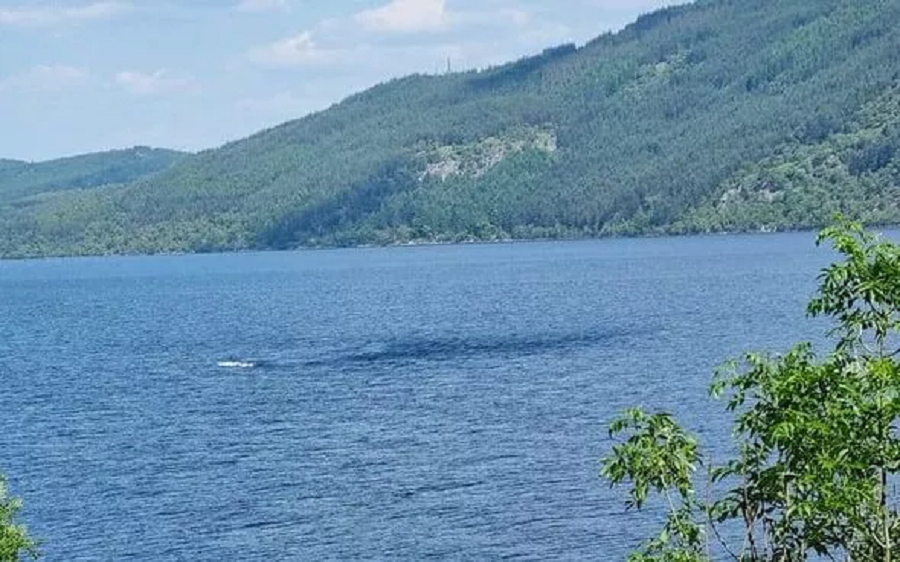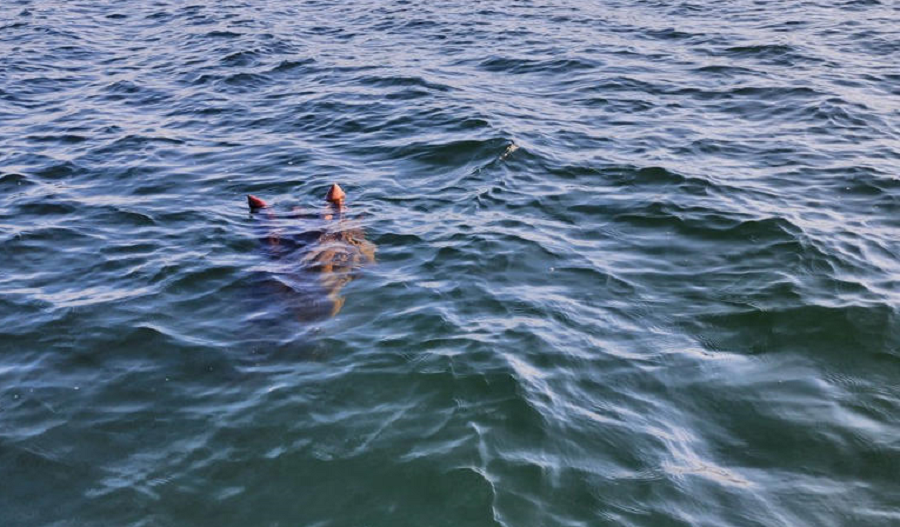Sonar Image of "Something Big" in Loch Ness Marks Second "Official" Nessie Sighting Report of 2022
A photograph of the sonar screen taken by Tom Ingram, with the mysterious object circled in red. (Tom Ingram)
Tom Ingram, 36, of Portsmouth, England, was aboard the cruise ship 'Spirit of Loch Ness' when, at approximately 1:26 p.m. on April 4th, he said he saw "something big" on the ship's sonar.
The ship had departed from Fort Augustus with a load of tourists for a scenic trip across Scotland's famous Loch Ness less than 30 minutes before, and was near the turning point at Invermoriston when the sighting occurred.
"We decided to take one of the regular cruises from Fort Augustus to get some scenic photos of the loch whilst we are here," Ingram told the Mirror. "At around the halfway point, just off Invermoriston, we were alerted to a strange shape forming on the sonar. At first, we thought it was part of the cruise—something for the tourists—but it quickly became apparent that what we were looking at was in real time and big. I'd class myself as 'open-minded' [about the existence of Nessie], of course we are aware of the myth, but to actually see something big on the sonar like that, took us both by surprise."
"At first, we were excited and then puzzled as to what we had seen," he added. "It certainly adds to the mystery!"
In the photograph taken by Ingram, a roughly 30-foot-long object can be seen at a depth of around 410 feet.
This is the second “official” sighting to be accepted by The Official Loch Ness Monster Sightings Register in 2022—following a sighting of something unusual in the water on March 30th by documentary filmmakers Warren Speed and Jamie Huntley—and the fifth such sonar capture to be recorded in Loch Ness since 2019.
Boat skipper Mike Bell captured a mysterious sonar return on June 27th, 2019, while piloting a group of tourists around Loch Ness aboard the 'Nessie Hunter,' followed by another such capture on August 26th, 2021.
Two other sonar images were captured by Cruise Loch Ness director Ronald Mackenzie while piloting the ‘Spirit of Loch Ness’ in late 2020.
Mackenzie's 2020 sonar images were recorded within two weeks and one mile of each other in the loch, off of Invermoriston, near the location of the most recent capture.
Sonar expert Craig Wallace—a marine robotics senior application specialist with Kongsberg Maritime AS, who has surveyed Loch Ness half a dozen times and six years ago discovered the lost model of Nessie used in the 1970 film The Private Life of Sherlock Holmes—described the 2020 images as "very curious."
"These are of course large, clear and distinct contacts, all strangely near to the loch bed," Wallace told The Inverness Courier. "It is very well known that Loch Ness has been subject to several excursions with sonar to find Nessie, but the technology used—although cutting edge at the time—was designed for bottom mapping operations. Hence it would try to track the seafloor and not necessarily find mid-column targets. Modern technology employs new techniques whereby the entire water column is mapped accurately and perhaps in the future we will start a program to capture this data correctly in Loch Ness."
Wallace remained skeptically open-minded, saying that, "While we could never rule out Nessie's existence—as our swath or coverage at any one time would be too small—perhaps the extra scientific data would justify the venture. If any groups would be willing to sponsor the attempt, I would love the opportunity to attend with these types of sonar."
"It is hard to tell if it is a single creature or a large shoal of fish, which in itself would be unusual for Loch Ness. You don't normally find such a shoal in that loch and so far down," he continued. "These fascinating images are genuine and unexplained contacts that would merit further investigation of the loch by more sophisticated sonar.”
Mackenzie seemed open to cooperation with Wallace in investigating the mystery.
“I would welcome Mr. Wallace bringing his equipment and we will take him out to try and find out what’s going on. I have no idea," he said. "I just wonder if it is due to lockdown. There’s been nothing moving (boats) on the surface of that loch and I wonder if that has encouraged it to move about. I just don’t know. I can’t explain it. I was reluctant to even make it public."
Mackenzie said he sent the first images to the sonar manufacturer, who told him that "the contact was 15 to 20 feet long and a single creature.”
“It is too big to be a salmon and at that depth,” he said. “There is no way it’s a very large salmon. It could be something that has come in to the loch. I have spent more time on Loch Ness than anybody I know and I can’t explain why suddenly we are getting these sonar contacts all of a sudden. It’s just incredible. I honestly think it’s a big fish of some sort, known or unknown to the loch."
"I have been over that area for decades, tens of thousands of times," Mackenzie added. "Now we have two similar contacts and in the middle of the loch. The latest looks the same. I've no idea what it is."
Nessie investigator Steve Feltham described the sonar images as "the most compelling case for a big creature swimming around Loch Ness."
“All the contacts are near the bottom or in the first 100 feet up. It is a game changer—the first indisputable sighting of something very big and unexplained that's in there," he said. "It is not explainable by any known phenomenon in Loch Ness. That's why I have sat and waited here all these years. We have had so many rubbish sightings over the years—of boat wakes or logs. But this is in a different league."
Feltham speculated that the images could represent a particularly large natural specimen.
"I am not keen on the idea it could be a sturgeon, but it might be a Wels catfish," he said. "It is possible. I would think there's very few of them, though. If there's been a small population we could be looking for the last one left. We don't know how long they live for—at least we know there is this one and it would be nice to find it before it's too late, because it seems to inhabit the bottom and rarely come to the surface."
A 2019 study by Neil Gemmell, a New Zealand scientist and professor at the University of Otago, found no evidence of any large animals such as sturgeon, catfish, sharks, or surviving prehistoric plesiosaurs in Loch Ness, but it did find an abundance of eel DNA.
This has caused some to speculate that perhaps these sonar images show a species of giant eel.
Others have dismissed the images captured aboard ‘Nessie Hunter’ as schools of fish, although those recorded by Mackenzie don’t lend themselves easily to that explanation.
Ultimately, the sonar images remain unexplained.
To report your own encounter with the impossible, reach out to us directly at the Singular Fortean Society through our contact page.
If you enjoyed this article and would like to support the Singular Fortean Society, please consider becoming an official member by signing up through our Patreon page—membership includes a ton of extra content and behind-the-scenes access to the Society’s inner workings.





















